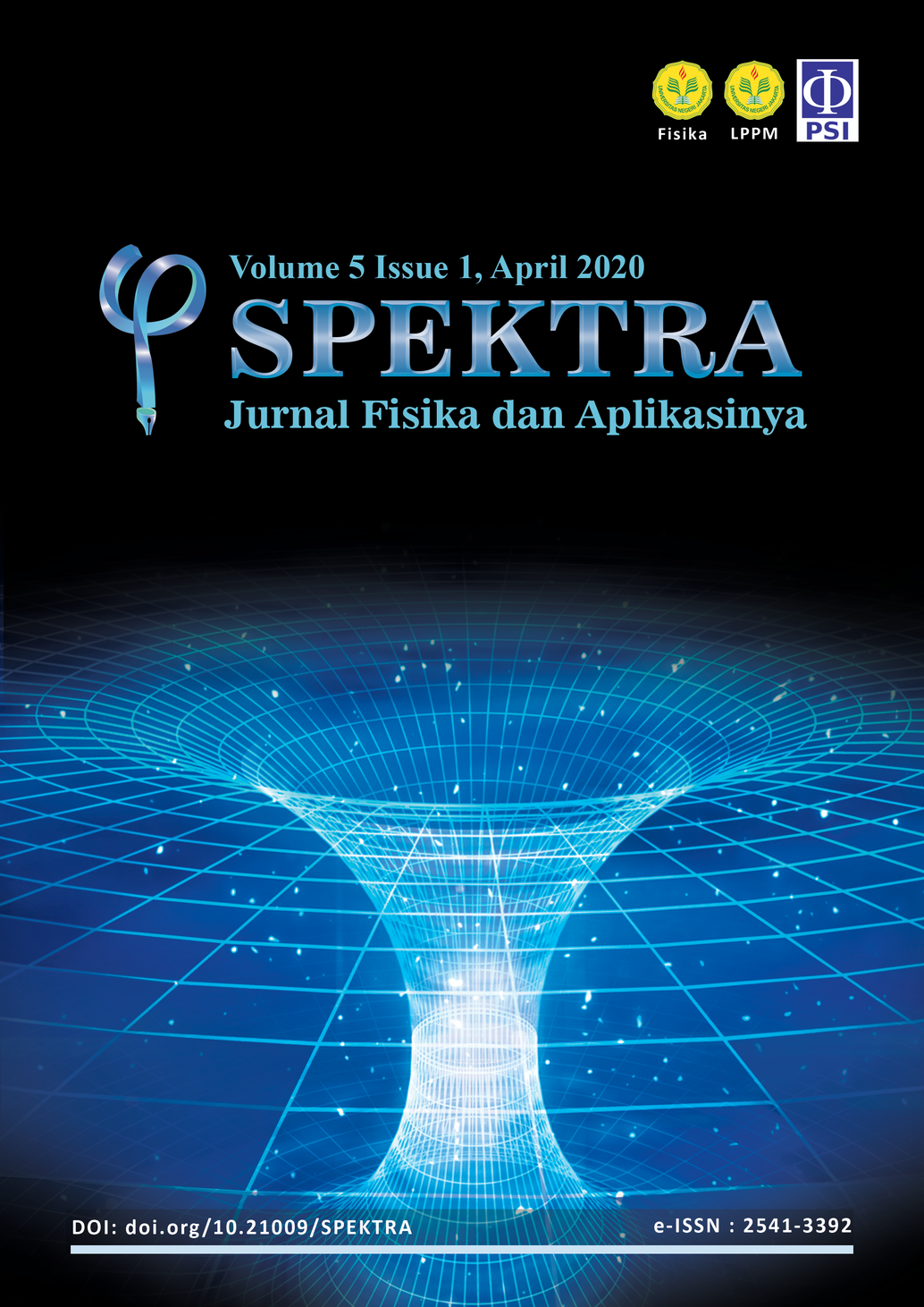THE OUTBREAK’S MODELING OF CORONAVIRUS (COVID-19) USING THE MODIFIED SEIR MODEL IN INDONESIA
DOI:
https://doi.org/10.21009/SPEKTRA.051.07Keywords:
COVID-19, corona-virus, matlab, SEIR model, modelingAbstract
Coronavirus Disease 2019 (COVID-19) is an infectious disease caused by a new type of virus called SARS-CoV-2, and by the beginning of 2020 had spread throughout the world, including Indonesia. A high rate of spread of COVID-19 causes the number of patients that infected increase significantly. In this study, mathematical modeling was carried out to predict the number of COVID-19 patients and the duration of the COVID-19 pandemic in Indonesia. The model used is a modified SEIR model (Susceptible, Exposed, Infected, Recovered) with several assumptions such as a constant and homogeneous population, patients who have recovered can not be infected, and the spread only occurs from human to human. In addition, it is assumed that there are individuals who carry out quarantine and isolation. Modeling is done using the help of MATLAB R2015a. The modeling results show that the peak of the COVID-19 pandemic in Indonesia will occur in the middle of May 2020, and the number of infected patients will be about 15000 people. This amount can be reduced if the quarantine and self-isolation process is carried out optimally.
References
[2] G. Kampf et al., “Persistence of coronaviruses on inanimate surfaces and its inactivation with biocidal agents,” Journal of Hospital Infection, 2020.
[3] C. Rothe et al., “Transmission of 2019-nCoV infection from an asymptomatic contact in Germany,” New England Journal of Medicine, 2020, vol. 382, no. 10.
[4] Q. Li et al., “Early transmission dynamics in Wuhan, China, of novel coronavirus–infected pneumonia,” New England Journal of Medicine, 2020.
[5] T. Liu et al., “Transmission dynamics of 2019 novel coronavirus (2019-nCoV)”, https://ssrn.com/abstract=3526307, 2020.
[6] M. Batista, “Estimation of the final size of the coronavirus epidemic by the logistic model,” medRxiv, 2020.
[7] Y. Huang et al., “Epidemic situation and forecasting of COVID-19 in and outside China,” [Submitted], Bull World Health Organ. E-pub: 16 March, 2020.
[8] WHO, Novel Coronavirus (2019-nCoV) Situation Report-7 - World Health Organization (WHO), Jan. 27, 2020.
[9] S. A. Lauer et al., “The incubation period of coronavirus disease 2019 (COVID-19) from publicly reported confirmed cases: estimation and application,” Annals of internal medicine, 2020.
[10] J. A. Backer et al., “Incubation period of 2019 novel coronavirus (2019-nCoV) infections among travellers from Wuhan, China, 20–28 January 2020,” Eurosurveillance, 2020.
[11] Z. Tang, L. Xianbin and H. Li, “Prediction of New Coronavirus Infection Based on a Modified SEIR Model,” medRxiv, 2020.
[12] P. Shi, C. Shengli and F. Peihua, “SEIR Transmission dynamics model of 2019 nCoV coronavirus with considering the weak infectious ability and changes in latency duration,” medRxiv, 2020.
[13] BPS, “Proyeksi Penduduk Indonesia 2010–2035/BPS-Statistics Indonesia, Population Census and Indonesia Population Projection 2010–2035,” 2010.
Downloads
Published
How to Cite
Issue
Section
License
SPEKTRA: Jurnal Fisika dan Aplikasinya allow the author(s) to hold the copyright without restrictions and allow the author(s) to retain publishing rights without restrictions. SPEKTRA: Jurnal Fisika dan Aplikasinya CC-BY or an equivalent license as the optimal license for the publication, distribution, use, and reuse of scholarly work. In developing strategy and setting priorities, SPEKTRA: Jurnal Fisika dan Aplikasinya recognize that free access is better than priced access, libre access is better than free access, and libre under CC-BY or the equivalent is better than libre under more restrictive open licenses. We should achieve what we can when we can. We should not delay achieving free in order to achieve libre, and we should not stop with free when we can achieve libre.
 SPEKTRA: Jurnal Fisika dan Aplikasinya is licensed under a Creative Commons Attribution 4.0 International License.
SPEKTRA: Jurnal Fisika dan Aplikasinya is licensed under a Creative Commons Attribution 4.0 International License.
You are free to:
Share - copy and redistribute the material in any medium or format
Adapt - remix, transform, and build upon the material for any purpose, even commercially.
The licensor cannot revoke these freedoms as long as you follow the license terms.

 E-ISSN 2541-3392
E-ISSN 2541-3392  Focus & Scope
Focus & Scope  Editorial Team
Editorial Team  Reviewer Team
Reviewer Team  Author Guidelines
Author Guidelines  Article Template
Article Template  Author Fee
Author Fee  Publication Ethics
Publication Ethics  Plagiarism Policy
Plagiarism Policy  Open Access Policy
Open Access Policy  Peer Review Process
Peer Review Process  Retraction & Correction
Retraction & Correction  Licensing & Copyright
Licensing & Copyright  Archiving & Repository
Archiving & Repository  Contact
Contact  Mendeley
Mendeley 

